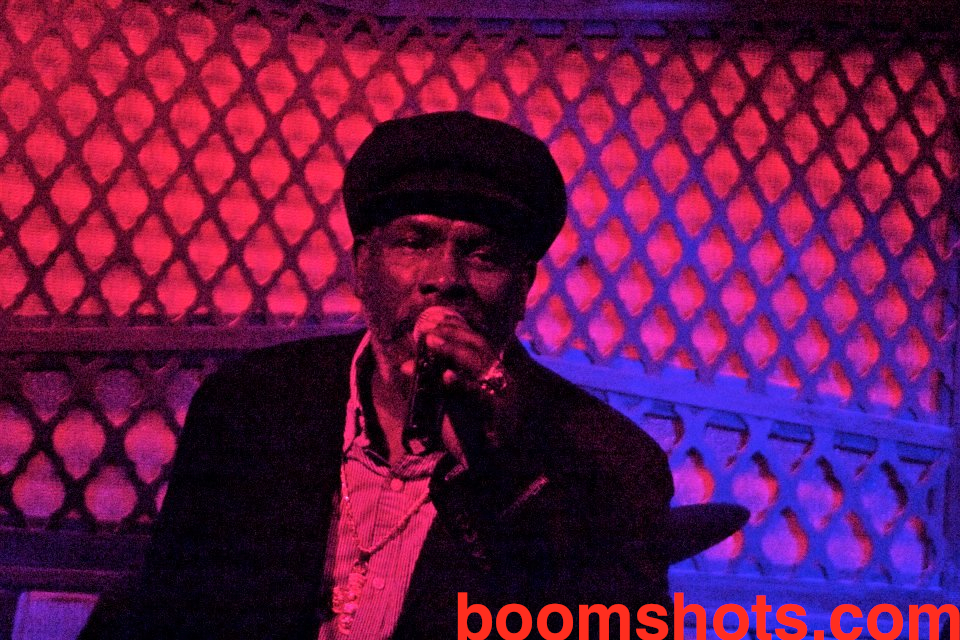Reggae Legend Rocks Out In Harlem Backed By The Full Watts Band
 Photograph by Paul Holgerson
Photograph by Paul Holgerson
Ten-thirty p.m., Saturday, May 19, in Harlem. I’m sitting at a table in Ginny’s Supper Club below the Red Rooster, 125th and Lenox. Across this art deco revival Harlem nightclub, the funky rounded edges of the window to the deejay booth frames esteemed reggae producer Clive Chin and his operator Fidel ‘Twice’ Luna. My friend Sam leans to me and says, “Can you believe we’re sitting in a place like this, listening to music like this?” Ginny’s stands in obvious contrast to the Brooklyn basements and warehouses and lofts with bare walls and bare lightbulbs where we usually have to stay up until 3 a.m. to hear reggae from the vinyl deep. Twice drops the needle into a Clive Chin-produced cover of “Mission Impossible,” the right track played at the right time. The pot is bubbling…
Wax Poetics publisher Andre Torres had called me on May 11 and said he needed a reggae group for the birthday party of one of the owners of the Red Rooster in Harlem. The event would be eight days later, the 19th. It was the kind of request I enjoy–risky and irresponsible, with the prospect of damaging my reputation. I made some calls, and to my pleasant surprise, nine days later I was soaking it in with good friends.
Chef Marcus Samuelsson is the establishment’s public face, but the evening’s festivities centered around the birthday party for one of Ginny’s reggae-loving owners, Andrew Chapman.
I’d heard Full Watts two or three times at their home base of Two Boots in Park Slope. They play rock steady and early reggae covers with a sincerity that seems to be maturing into something extraordinary, especially given that they have done less than ten performances as a fully formed outfit. Bandleader Eddie Ocampo deserves the lion’s share of the credit for the rock steady foundations. Full Watts reminds me of the Blue Riddim Band, a greatly respected Kansas City-based group that Osbourne once famously joined onstage 30 years ago.
Johnny Osbourne “We Need Love”
It’s no secret that Osbourne’s catalog of recordings from the 70s through the 90s is exceptional. What’s particularly compelling is that he was one of very few of the early reggae era singers who not only stepped across the digital divide in Jamaican music but actually helped tear open the fabric of the reggae-space continuum with a signature hit on the “Sleng Teng” riddim (“Put It By Number One” a.k.a “Mr Budy Bye”).
Osbourne was as comfortable in the post-1985 dance as he had ever been. Likely, it was that his late 70s and early 80s output with Studio One, Volcano, and Jammy’s was quintessentially ‘dancehall’—songs hammered into zinc fences through live performance in the ultimate proving ground of artist-audience proximity. The sound had changed but Osbourne’s sense of himself and his place in the community was unwavering.
Not only did Osbourne make relevant music well into the 90s, his voice still shows little signs of age in 2012. Contrast that to his peers Dennis Brown, Gregory Isaacs and the seemingly irrepressible Sugar Minott. All of them crossed the digital divide too, but all are now gone.
Osbourne’s aversion to perform locally has earned him the criticism of some of his peers, but the sense of anticipation created by this performance obviously played to his favor.
After an early set from Full Watts and a scorching deejay set from Clive Chin and Twice, Johnny Osbourne took the stage around 11:30 p.m.
and proceeded to give a master-class in stagecraft (and dare I say “dancehall”?) for a full hour: “Murderer,” “Lend Me Your Chopper,” “Ice Cream Sound,” “Put It By,” “Yo Yo,” “Give a Little Love,” “Come Back Darling,” “Truth and Rights,” “Jah Promise,” and “Folly Ranking” among others.
Johnny leveraged Full Watts’ tight execution and lush harmonies and rode the riddims with a veteran’s authority, skatting with an intensity that demonstrated his total embrace of the moment. He predictably stop-started the band at every bawl of ‘forward’ from the crowd, which may have been for every single song. Such is the level of recognition among Osbourne’s many fans who had ventured out for the performance. The audience pumped up Johnny Osbourne, and Johnny Osbourne responded. It was a loving serenade and revealed again the essence of the artist-audience rapport that defines Jamaican popular music.
There were numerous highlights of course, but none for me could top the magic of “We Need Love,” originally collected on Osbourne’s iconic Truth and Rights LP for Studio One, a top drawer set in producer Coxson Dodd’s incomparable catalog.
Riding the backing track to Otis Gayle’s cover of the Spinners “I’ll Be Around,” (this is dancehall, remember), “We Need Love” paints a picture with the irrepressible optimism, born out of faith, that Jamaica continues to show the world. “When I was a young boy, we used to go to church every Sunday/There was handclapping, foot-stomping music/We used to dance in the name of the Lord …” Even if you never get the chance to be in a Jamaican church and listen to the preacher and the choir, or to just stand outside and take it in along with the piping sounds of the tree frogs or the lapping of waves from the ocean, you can live vicariously through the soul of this song.
Johnny O is telling you all you really need to know.
“What a beautiful feeling, if the whole wide world could join in…” Run that…
Johnny Osbourne “We Need Love” Live
Leave a Reply